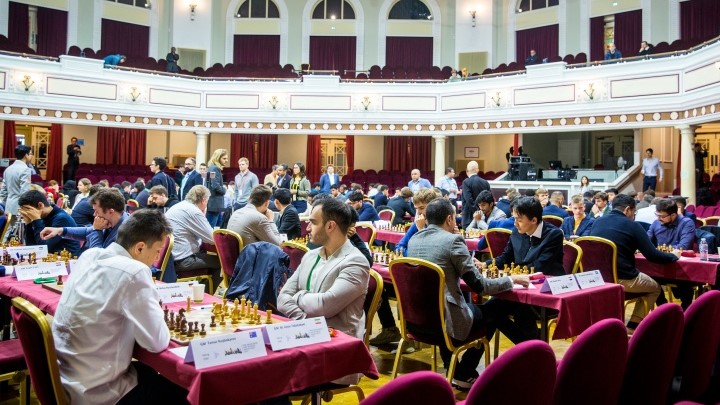Winners crowned at World Cadets Chess Championship 2023

The World Cadets Chess Championship 2023 is in the books. Held in six categories (Open U-8, Girls U-8, Open U-10, Girls U-10, Open U12 and Girls U-12), the competition took place from October 16-26 in the International Youth and Sport City, Sharm El Sheikh, Egypt. The event attracted 502 young players representing 66 national federations. It was a close affair in most sections, but two of them – U8 and U8 Girls – were dominated by Roman Shogdzhiev (FIDE) and Bodhana Sivanandan (ENG), winning all eleven games. Xue Tianhao of China put in an excellent performance (10.5/11) in the U10 Girls tournament and clinched the title with a round to spare. Devindya Gunawardhana (Sri Lanka) and Diana Preobrazhenskaya (FIDE) tied for first place in the U12 Girls section, with the former claiming gold as the winner of their direct encounter. The champions and top-finishers of the World Cadets Chess Championship: U8 1. Shogdzhiev, Roman (FIDE)2. Gafurov, Aidan (FIDE)3. Andre, Tomas (SVK) U10 1. Kuandykuly, Danis (KAZ)2. Guo, Ethan (USA)3. Banerjee, Supratit (SCO) U12 1. Dau, Khuong Duy (VIE)2. Nguyen, Nam Kiet (VIE)3. Ahmad, Khagan (AZE) U8 Girls 1. Sivanandan, Bodhana (ENG)2. Yi, Ruiyu (CHN)3. Tran, Hoang Bao An (VIE) U10 Girls 1. Xue, Tianhao (CHN)2. Guzman Garcia, Mia Fernanda (MEX)3. Zavivaeva, Kristina (FID) U12 Girls 1. Gunawardhana, Devindya Oshini (SRI)2. Preobrazhenskaya, Diana (FIDE)3. Altynbek, Aiaru (KAZ) During a brief closing ceremony, FIDE Special Tasks Director Akaki Iashvili thanked all the participants and expressed his gratitude to the President of the Egyptian Chess Federation, Hesham Elgendy, General Mayor of Sharm El-Sheikh representing Governor of South Sinai Ramah Hashim, Senator Ramy Galal, Deputy Minister of Sports of Egypt Mohamed Fathi for their support of the event. Photos: Sergei Indeikin Official website: wccc2023.com/
FIDE Grand Swiss: Trench warfare in Round 2

Wins don’t come easily, so draws are a normal occurrence at the FIDE Grand Swiss. Only a handful of players are on 100% in both sections. Fabiano Caruana extended his streak against Hans Niemann in classical games. Anish Giri and Alireza Firouzja scored their first wins, and Nakamura drew again. The Muzychuk sisters both won, though in a completely different manner, while top seed Goryachkina is still on 50%. A lot of players freely share their thoughts on various matters on social media nowadays. Sometimes, these matters concern their opponents, and the things said, while always interesting to the public, can be informative, condescending, disapproving or even critical of the players they meet over the board. In one of his recent videos, Fabiano Caruana described the scenario of his games against Hans Niemann. According to Caruana, he would obtain a comfortable position out of the opening, increase it almost to a winning one, and then, in mutual time-trouble, Niemann would defend excellently. Caruana would lose almost all of the advantage; they would transpose to an endgame where he would still press for a win, and at the end, Niemann would make the decisive mistake. So far, they have played four classical games, and they were all won by Caruana. As fate would have it, the second round of the FIDE Grand Swiss saw this very interesting match-up on board one. Given his 0-4 record, Niemann chose the most solid of all openings, the Berlin in Ruy Lopez. Caruana spent some time deciding what to do against it and went for his preferred 4.d3 followed by 5.Bxc6. Elite players like these positions with plenty of options and an equally huge number of possible move orders and transpositions. Herein lies the popularity of the Giuoco Piano, for example. As usual in these positions, a manoeuvring game followed. The position underwent different transformations more than once, but Black was doing fine. Then, an unexpected mistake happened. In this seemingly innocuous position, there is more danger for Black than it might appear at first sight. The best was the composed 22…Qc7, keeping the pieces together. After Niemann’s 22…Qa6? Caruana pounced with 23.Rxd8 Rxd8 24.Rd1 when suddenly the wayward position of the queen on a6 meant that Black could not satisfactorily protect the seventh and eighth ranks. Niemann defended the eighth by avoiding the exchange of rooks, but after 25.Rd7 followed Qf3xb7, Caruana completely tied down Niemann’s pieces and won the game. Caruana-Niemann 5-0. Alexandr Predke outplayed and eventually checkmated Jan-Krzysztof Duda in a very complex middlegame position that arose from the Vienna Variation in the Queen’s Gambit Declined. White wrapped things up with a powerful attack. 28.Nxh5+! gxh5 29.Bh6+ Kf7 30.Qg7+ and Duda resigned, facing imminnent 31.Qf8# 1-0 One of the players who has a chance to qualify for the Candidates via the FIDE Circuit, Anish Giri, scored his first win after Rasmus Svane (White) lost his way in the complications. Everything is hanging, so calculation is everything. Svane didn’t manage to navigate the rough waters and played 18.Ncd6? instead of 18.Bd6 or 18.Nbd6. After 18…Bc6 19.Nxe8 Nxe5 White eventually ended up a piece down. Hikaru Nakamura couldn’t do much with Black against Raunak Sadhwani’s Alapin Sicilian. It’s curious that Nakamura has tested the Alapin himself quite often recently, so the young Indian offered him a chance to play against his own preferred weapon. Nakamura did better than his online opponents by drawing the game. The leading group scoring 2/2 includes Fabiano Caruana, Alexandr Predke, Arjun Erigaisi, Andrey Esipenko, Alexey Sarana, Erwin L’Ami and the rare non-grandmaster Ramazan Zhalmakhanov. The young IM from Kazakhstan already made a splash by beating Alan Pichot and Bassem Amin in the first two rounds. In the women’s section, Anna Muzychuk and Stavroula Tsolakidou played a very sharp line in the Alapin Sicilian, recently tested in online games by both Carlsen and Caruana with the black pieces. The position was inherently more dangerous for Black, so when preparation (or the memorized variations) ended, it was more difficult for Black to come up with good moves. Therefore, it wasn’t surprising that Stavroula faltered first. In this critical position, Black had to make the only move 15…Be6, while 15…0-0? (it is natural to move the king out of the centre as soon as possible, but unfortunately for Tsolakidou it didn’t work) failed to 16.Ne4 g4 17.Qb3, and with threats like Bd6 and Rae1, White was close to winning already. Muzychuk didn’t make the most of her advantage and allowed her opponent to come back into the game and obtain counter-chances. The game saw a dramatic finale in mutual time trouble. Instead of exchanging queens and then taking the knight on c5, which would have led to a draw, Muzychuk took on d4, 34.Qxd4?? which allowed Black to win on the spot with the tactical shot 34…Nd7! that allows her to cover from the discovered check with …Nf6 while White cannot take on c8 twice in view of the weak back rank after …Qb1. Tsolakidou missed this chance and went for 34…Nb3? which only led to an equal position. On the last move of the time-control, the following happened. The position is equal as White’s extra pawn is compensated by Black’s counterplay against the opponent’s king. However, with her last seconds on the clock, Tsolakidou played 40…Qh6???, completely forgetting her rook on e8. A heart-breaking loss for Tsolakidou and a lucky break for Muzychuk. Compatriots Mihaela Sandu and Irina Bulmaga played an incredibly wild game. In the Ruy Lopez, Black chose the Siesta Variation, played by Capablanca against Reti in 1928. Both Reti and Sandu went for the dubious 7.Ng5?! (instead of 7.Nxe5, which should lead to an unclear position that is objectively balanced). This seems to be a blind spot in modern theory because even Caruana played the same move in an online game against Adhiban! After 7…exd4, Sandu deviated from the games of the luminaries with the inferior 8.0-0, instead of 8.Nxe4. Objectively, this wasn’t very good, but it led to fireworks after 8…d5 9.c4!? b5?! Instead of this flashy move, the developing 9…Nf6 would have given Black an almost decisive advantage. In the game after 10.cxb5 (taking on d5 was better) axb5 11.Bxb5 Bulmaga played the awkward 11…Nge7, voluntarily shutting her kingside when 11…Qd7, with the idea of Ba6 was superior. After almost 18

